St Mark's, Mayfair, is a Grade I listed building, a former Anglican place of worship in North Audley Street, in the Mayfair district of London.
St Mark's, Mayfair, is a Grade I listed building, a former Anglican place of worship in North Audley Street, in the Mayfair district of London.
St Mark's was built in 1825–28 [1] as a response to the shortage of churches in the area. The population in Mayfair had grown with the demand for town houses by the aristocracy and the wealthy, as they moved in from the country. [2] [3]
The building was constructed in the Greek revival style to the designs of John Peter Gandy. Gandy produced most of his work in Neo-classical designs, with St Mark's being one of the finest examples.[ citation needed ]
In 1878 architect Arthur Blomfield made substantial changes to the church interior, introducing a Romanesque open roof structure, wall decoration and architectural detail. [1] The 34 feet (10 m) façade, together with the elegant porch, is known as one of the finest in London.[ citation needed ]
The church was listed Grade I in 1958. [1] It was deconsecrated in 1974 and remained empty for many years, being included on English Heritage’s "Buildings at Risk" register for over 20 years.[ citation needed ]
In July 2014 the building was acquired by Grosvenor Estates. [4]
Edward Thomas Daniell, known for his watercolour paintings of the Near East and his etchings of Norfolk, was appointed to the curacy of the church in 1834. [5]
During the Second World War, St Mark's became informally known as The American Church in London due to its proximity to the United States embassy and as a centre for American worshippers. It was visited by President Dwight Eisenhower and the political figure, diplomat and activist Eleanor Roosevelt when she was First Lady of the United States. [6]
| External videos | |
|---|---|
| St. Mark’s Church | |
On the 29 September 1949, St. Mark's was the venue for the wedding of George Lascelles, 7th Earl of Harewood and pianist Marion Stein, which was attended by King George VI and other members of the royal family. A wedding anthem specially composed and conducted by Benjamin Britten was performed at the service. [7]
The congregation dwindled during the 1950s and 1960s, until the church was declared redundant in 1974.[ citation needed ] It remained empty from 1975 to 1994.[ citation needed ] That year the Diocese of London allowed the use of the church by The Commonwealth Christian Fellowship led by Rod and Julie Anderson, who met there with a congregation of around 120 and provided an out-reach programme for anti-knife crime training for teenagers, home visits for elderly people and help for the homeless. The church was used in this way until 2008.[ citation needed ]
Between February and May 2015 the church hosted This Present House.[ citation needed ]
St Mark's has musical associations with Victorian opera, with the opera oratorio singer Sir Charles Santley and also with the composer Sir Arthur Sullivan. J. W. Elliott, a former organist at the church, composed the tune "Day of Rest" for the hymn "O Jesus I Have Promised". [8]
Both John Williams, the first Master of Music at the Tower of London, and Margaret Cobb, the first woman to play the organ at the BBC Proms at Royal Albert Hall, were organists at the church. [9] [8]
The church has a three-manual organ by J. W. Walker & Sons Ltd which has recently been re-commissioned. There are plans to re-develop the instrument, with the assistance of organ builders Bishop and Son. [8] The original Rushworth and Dreaper organ was relocated to Holy Trinity Brompton. [10] St Mark's has held concerts by the London Russian Music School and it has also been the venue for concerts by such musicians as violinist Nicola Benedetti, and other choirs and ensembles from the locality. [8]

Hammer Holdings Limited successfully applied for planning permission to convert the building into a 'wellness centre' in 2006, but a campaign led by Lady Sainsbury succeeded in blocking the proposal. [11]
It was subsequently acquired by One Events in 2009 to use as a mixed-use venue.[ citation needed ] The building has been used for other events, such as by Nike, The London Summer Show, [12] London Fashion Week and by Grosvenor Estates. [13] In July 2014 the building was acquired by Grosvenor Estates. [4] Since November 2019 St Mark's has been Mercato Mayfair, a food hall operated by Mercato Metropolitano. [14]

Mayfair is an affluent area in the West End of London towards the eastern edge of Hyde Park, in the City of Westminster, between Oxford Street, Regent Street, Piccadilly and Park Lane. It is one of the most expensive districts in the world.

Pimlico is an area of Central London in the City of Westminster, built as a southern extension to neighbouring Belgravia. It is known for its garden squares and distinctive Regency architecture. Pimlico is demarcated to the north by Victoria Station, by the River Thames to the south, Vauxhall Bridge Road to the east and the former Grosvenor Canal to the west. At its heart is a grid of residential streets laid down by the planner Thomas Cubitt, beginning in 1825 and now protected as the Pimlico Conservation Area. The most prestigious are those on garden squares, with buildings decreasing in grandeur away from St George's Square, Warwick Square, Eccleston Square and the main thoroughfares of Belgrave Road and St. George's Drive. Additions have included the pre–World War II Dolphin Square and the Churchill Gardens and Lillington and Longmoore Gardens estates, now conservation areas in their own right. The area has over 350 Grade II listed buildings and several Grade II* listed churches. At the western edge of Pimlico, on the borders of Chelsea, Pimlico Road has become known in recent years for its interiors and design stores.

Hugh Lupus Grosvenor, 1st Duke of Westminster,, styled Viscount Belgrave between 1831 and 1845, Earl Grosvenor between 1845 and 1869, and known as The Marquess of Westminster between 1869 and 1874, was an English landowner, politician and racehorse owner. He inherited the estate of Eaton Hall in Cheshire and land in Mayfair and Belgravia, London, and spent much of his fortune in developing these properties. Although he was an MP from the age of 22, and then a member of the House of Lords, his main interests were not in politics, but rather in his estates, in horse racing, and in country pursuits. He developed the stud at Eaton Hall and achieved success in racing his horses, winning the Derby on four occasions.

Mount Street Gardens is a public garden off Mount Street in the west of the Mayfair area of London, England. The gardens were created in 1889 out of a former burial ground of St George's, Hanover Square, and named after the Mount Field, an area including a fortification dating from the English Civil War named Oliver's Mount.

Grosvenor Square is a large garden square in the Mayfair district of Westminster, Greater London. It is the centrepiece of the Mayfair property of the Duke of Westminster, and takes its name from the duke's surname "Grosvenor". It was developed for fashionable residences in the 18th century. In the 20th it had an American and Canadian diplomatic presence, and currently is mixed use, commercial.

The Church of Saint John the Baptist is an active Anglican parish church in the Diocese of Liverpool and lies in the archdeaconry of Liverpool and the deanery of West Derby. It is situated on the corner of West Derby Road and Green Lane, in Tuebrook, Liverpool, England. It was built in the 1860s to a design by GF Botley and is Grade I listed, as a building of exceptional architectural interest. The site also contains the Victorian vicarage and a mortuary house, also by Botley and both Grade II listed. It is also the site of the Brockman Memorial Hall, an early venue of the Beatles.

Albemarle Street is a street in Mayfair in central London, off Piccadilly. It has historic associations with Lord Byron, whose publisher John Murray was based here, and Oscar Wilde, a member of the Albemarle Club, where an insult he received led to his suing for libel and to his eventual imprisonment. It is also known for its art galleries and the Brown's Hotel is located at 33 Albemarle Street.

Union Chapel is a working church, live entertainment venue and charity drop-in centre for the homeless in Islington, London, England. Built in the late 19th century in the Gothic revival style, the church is a Grade I-listed building. It is at the north end of Upper Street, near Highbury Fields.

Leeds Minster, or the Minster and Parish Church of Saint Peter-at-Leeds is the minster church of Leeds, West Yorkshire, England. It stands on the site of the oldest church in the city and is of architectural and liturgical significance. A church is recorded on the site as early as the 7th century, although the present structure is a Gothic Revival one, designed by Robert Dennis Chantrell and completed in 1841. It is dedicated to Saint Peter and was the Parish Church of Leeds before receiving the honorific title of "Minster" in 2012. It has been designated a Grade I listed building by Historic England.
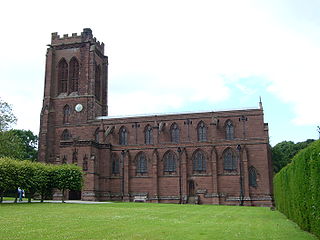
St Mary's Church is in the village of Eccleston, Cheshire, England, on the estate of the Duke of Westminster south of Chester. The church is recorded in the National Heritage List for England as a designated Grade I listed building. It is an active Anglican parish church in the diocese of Chester, the archdeaconry of Chester and the deanery of Chester. Its benefice is combined with that of St Mary, Pulford. The Dukes of Westminster are buried in the adjacent Old Churchyard.
Thomas Cundy the younger was an English architect, son of another architect of the same name. He joined his father's practice and ultimately succeeded his father as surveyor of the Grosvenor Estate, and held the position during the main phase of the development of Belgravia and Pimlico by the contractor Thomas Cubitt.
Edward Shepherd was a prominent London-based English architect and developer in the Georgian period.
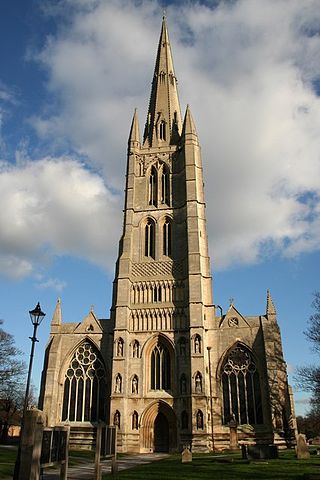
St Wulfram's Church, Grantham, is the Anglican parish church of Grantham in Lincolnshire, England. The church is a Grade I listed building and has the second tallest spire in Lincolnshire after Louth's parish church.
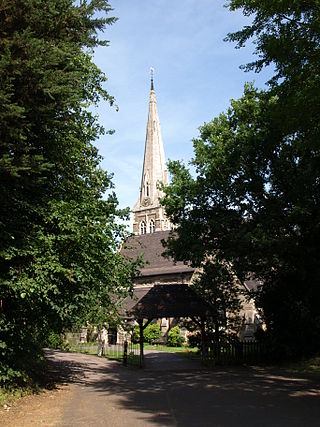
St. Mary's Church, Selly Oak is a Church of England parish church in Selly Oak, Birmingham, England.

Grosvenor Chapel is an Anglican church in what is now the City of Westminster, in England, built in the 1730s. It inspired many churches in New England. It is situated on South Audley Street in Mayfair.
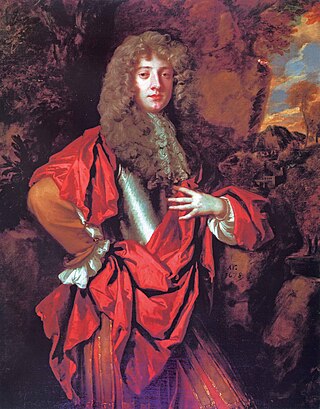
Sir Thomas Grosvenor, 3rd Baronet was an English Member of Parliament, and an ancestor of the modern day Dukes of Westminster. He was the first member of the family to build a substantial house on the present site of Eaton Hall in Cheshire.

Colonel Eustace James Anthony Balfour was a London-based Scottish architect. The brother of one British Prime Minister and nephew of another, his career was built on family connections. His mother was the daughter of a Marquess, and his wife Frances, a noted suffragist, was the daughter of a Duke. Frances's sister in-law was Princess Louise, daughter of the reigning Queen Victoria.

Eia or Eye was an early Medieval manor in the parish of Westminster, Middlesex and is now a part of Central London. It was about one mile west of the Palace of Westminster/Whitehall, about 2 miles west-south-west of the walled City of London, and about half a mile north of the River Thames.

South Audley Street is a major shopping street in Mayfair, London. It runs north to south from the southwest corner of Grosvenor Square to Curzon Street.
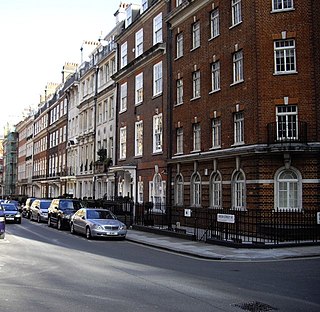
Green Street is a street in Mayfair, London. It has been built up since the mid-18th century, but most of the current properties date from the late 19th and early 20th century. It has had a number of significant residents, including various members of the British aristocracy, the James Bond author Ian Fleming, and the Beatles.
{{cite web}}: CS1 maint: numeric names: authors list (link)